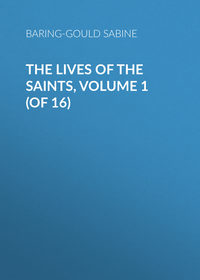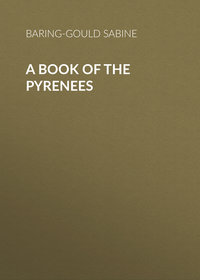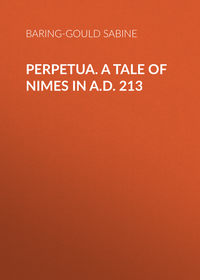 полная версия
полная версияThe Lives of the Saints, Volume III (of 16): March
The doctrines peculiar to the Albigenses were these: – There were two Creators, the good God, who was the author of the New Testament, and who made the world of good spirits; and the bad God, who was the author of the Old Testament, and Creator of the visible world, and of the evil spirits.10 This latter God they called a liar, because he told the first man: "The day thou eatest of the tree thou shalt surely die," and man did not die the same day that he broke the commandment; they also called him a murderer because he slew Pharaoh and his host, and the inhabitants of the Plain. This bad God was either a fallen angel,11 or the Son of the chief God and Creator, who had two sons, Christ and Satan.12 Others held that the good God had two wives, Colla and Coliba, by whom he begat many sons and daughters.13 Others, that the men made by the good God were good, but that through union with women, whom they derived from the Evil Principle, they fell.14 The creation of men was veiled in the following myth by some of the Albigenses. The devil made men out of clay, and bade God send into them souls. God answered, that men thus constructed would be too strong, "They would dethrone me." Whereupon Satan made man of the foam of the sea; and God said, "That is good, he is a mixture of strength and fragility." And he sent a soul into the man thus made.15 Generally the Albigenses held that there were two Christs; one bad, who was born in Bethlehem of Mary, and who was crucified; and another good, who had a phantom body and was purely spiritual, and who appeared on earth in the body of the Apostle Paul. The good Christ neither ate nor drank, but the bad Christ, the Son of Mary, lived as do other men, and had for concubine, Mary Magdalene.16
The Trinity was naturally rejected by the Albigenses, as incompatible with their Dualism. They also rejected the Old Testament as the work of the Evil Principle; and regarded Moses, the Prophet, and even John the Baptist, as possessed with evil demons.17
With regard to the future, some of the Albigenses taught that the souls of men were the fallen angels condemned to spend seven lives in human bodies. Others denied the existence of the soul altogether.18 With such disbelief in the immortality of the soul, or such notion of its being an angel in a state of purgation, the resurrection of the body, Purgatory and Hell were rejected; and with them, prayer for the dead and invocation of saints – for how pray for a soul which is annihilated, or how invoke an apostate angel?19
The idea of a visible Church, and the necessity of sacraments, could not be entertained with such a creed; and the Albigenses repudiated baptism, communion, and other rites. Marriage they denounced as fornication, and they condemned intercourse between man and woman as sin in the higher ranks of the elect.20 Others, however, said that fornication was no sin.21 But this refers to the lower order of the faithful.
The faithful were divided into two orders: the higher, or "perfect," who wore a black dress, abstained from marriage, the eating of flesh, eggs, and cheese; and the "believers," who gave free scope to their lusts, and whose salvation was due to a certain ceremony being performed over them by one of the "perfect," which was called the "consolation." If one of the perfect ate the least morsel of meat or cheese or egg, he sinned mortally, and all who had been consoled by him fell at the same time out of a state of grace, and it was necessary for them to be re-consoled; and even those who were saved fell out of heaven for the sins of him who had consoled them. The sacrament of consolation was performed by one of the "perfect" laying his hands upon one of the "believers," who repeated a Pater Noster; and such act placed the "believer" in a state of grace from which he could only fall by the fall of his consoler. This ceremony was performed at the point of death.
The ceremony of reception is thus described by Peter of Vaux-Cernaix: —
"When any one went over to the heretics, he who received him said, 'Friend, if you wish to be one of us, it behoves you to renounce the whole faith that is held by the Roman Church.' He must answer, 'I renounce.' 'Then receive the Holy Spirit from the good men,' and then he breathes seven times in his face. Also he says to him, 'You must renounce that cross which the priest made on you in baptism, on your breast, and on your shoulders, and on your head, with oil and chrism.' He must answer, 'I renounce it.' 'Do you believe that water can work your salvation?' He answers, 'I do not believe it.' 'You must renounce that veil which the priest placed on your head when you were baptized.' He must answer, 'I renounce it.' Thus he receives the baptism of the heretics, and denies the baptism of the Church. Then they all place their hands upon him, and kiss him, and clothe him with a black garment, and from that hour he is as one of themselves."
The ceremony of consolation, or heretication, was only performed at the point of death; but if the sick person should show signs of recovery, he or she was required to abstain from food, or to open a vein, so as to prevent convalescence and precipitate death. I may as well give a few instances which came under the notice of the inquisitors of Toulouse, from Limborch: —
"This admission was believed to save the soul of the person admitted, and was called spiritual baptism, the consolation, the reception, and the good end; and it was believed that those sanctified by it were bound from that moment to abstain from touching a person of another sex, and from food, or the soul fell from its state of purification. Thus we read of the trial of a woman whose father had been received amongst the Albigenses, 'that she was forbidden by her father to touch him, because after his reception no woman ought to touch him, and from that time she never did touch him.' (Fol. 49.) And in another woman's trial, 'that it was unlawful for her to touch Peter Sancii, and that she heard that it was reported amongst them that they neither touch a woman, nor suffer themselves to be touched by one.' (Fol. 68.) But inasmuch as it was possible that the person received might return to his former pollutions (says Limborch in his introduction to the Acts of the Inquisition), his reception was delayed to his last sickness, when there was no more hopes of recovery, that so he might not lose the good he had received; for which reason some were not admitted, though one of the Albigenses was present, because it was not believed they would immediately die. Thus it is reported of Peter Sancii (fol. 68) that having called 'to hereticate a certain sick woman, she was not then hereticated, because he did not think it proper, upon account of her not being weak enough.' And afterwards, though the distemper grew more violent, Peter Sancii did not hereticate her, because she recovered. As for those who were received during their illness, they were commanded to make use of the Endura, that is, fasting, and to hasten death by opening a vein and bathing. Thus it is related of a certain woman, that 'she persevered in the abstinence which they call the Endura many days, and hastened her bodily death by losing her blood, frequent bathing, and greedily taking a poisonous draught of the juice of wild cucumbers, mixing it with broken glass, that, by tearing her bowels, she might sooner die.' (Fol. 14-b.) Of another, it is said, 'that she was forbidden by her mother-in-law to give her little daughter, who had been hereticated by Peter Sancii, any milk to drink, by which the child died.' (Fol. 46.) Another confesses, 'that she had not seen her father since his heretication eating or drinking anything but cold water.' (Fol. 49.) But one Hugo, who continued several days in the Endura, did afterwards, by his mother's persuasion, eat and recover. (Fol. 63.) The same year, Peter Sancii invited him 'to enter into the Endura, and so to make a good end; but he would not agree to it till he came to die.' The same Hugo saw 'that Sancii procured and hastened his own death by bleeding, bathing, and cold.' Peter Auterii is said to have received another woman, 'and after her reception to have forbidden any meat being given to the said hereticated sick woman; and that there were two women who attended her, and watched that there should be neither meat nor drink given her the whole night, nor the following day, lest she should lose the good she had received, and contradict the order of Peter Auterii; although the said sick woman begged them to give her some food. But the third day after she did eat and grew well.' (Fol. 65-b.) In the sentence of Peter Raymund and of the Hugos, we read these things concerning the Endura: 'You voluntarily shorten your own corporal life, and inflict death upon yourself; because you put yourself in that abstinence, which the heretics call Endura, in which Endura you have now remained six days without meat or drink, and would not eat, nor will, though often invited to do so.' (Fol. 82-b.) However, all would not subject themselves to so severe a law. For we read of a certain woman 'that she suffered not her sick daughter, though near death, to be received; because then her said daughter must be put in the Endura.' (Fol. 71.) There is also an instance of a woman, who, for fear she should be taken up by the Inquisitors, put herself in the Endura; and sending for a surgeon, ordered him to open one of her veins in a bath, and after the surgeon was gone, she unbound her arm in the bath, that so the blood running out more freely, she might sooner die. After this she bought poison in order to destroy herself. Afterwards she produced a cobbler's awl, which in that barbarous age they called alzena, intending to run it into her side; but the women disputing among themselves, whether the heart was on the right side or the left, she at last drank up the poison, and died the day after. (Fol. 30-b)."22
Now a great deal of abuse has been poured on the Inquisition, and its crimes have been vastly exaggerated. Gieseler speaks of the bloodthirsty Inquisition as a "monster raging with most frightful fury in Southern France," – strong language for so calm an historian. But we ask, was it not necessary that such a system, destructive of life, should be put down? That the fautors of this atrocious self-murdering should be summarily dealt with, when they persuaded mothers to let their children perish on their sick-beds, men to pine themselves to death, and women to swallow broken glass, to tear their bowels, when their health began to amend? We have got the Acts of the Inquisition at Toulouse during sixteen years that it "raged with frightful fury," i. e., between 1307 and 1323. The whole number of cases reported is 932; but it is obvious that the same individual might, and in fact did, often reappear before the Inquisition more than once in the course of sixteen years. Having confessed some connection with heresy, he was sentenced to wear a little cross, or tongue of red cloth, let into the garments, or simply to wear a cross round the neck, or to make a pilgrimage to a certain church, or to use certain prayers; of such sentences 174 are recorded. If the person condemned to do this disobeyed, he was put in prison for a while; there were 218 such cases. If he escaped from prison, or ran away from the country, he was condemned as a fugitive; there were 38 of these. Some of the leaders of the heresy who had caused the death of many persons, and incorrigible heretics who had broken out of prison, were condemned to death; there were 40 fautors of heresy sentenced – twenty-nine Albigenses, seven Waldenses, and four Beghards; thirty-two of these were men, and eight were women. Among the sentences recorded are 113 remissions of penances, 139 discharges from prison, and 90 sentences of heresy pronounced against persons deceased.23
Now when we consider what these Albigensian "perfect" men were, and how dangerous they were to the well-being of society, by their influence over superstitious and ignorant peasants, urging them to self-murder, and thus causing the death of very many persons, we do not think that the Inquisition at Toulouse deserves all the odium that has been cast upon it. Many of those whom it condemned to death would probably have received a sentence of transportation for life in England at the present day; and though the execution of from two to three persons a year is certainly to be deplored, it is not just to denounce the Inquisition as bloodthirsty, when it sentenced to death those who had caused many innocent and ignorant persons to immolate themselves. We do not for a moment pretend to justify the Albigensian war; but we can understand the alarm caused to the Pope and to Christian France by the heathen reaction in Provence, Narbonne, and Toulouse. Nor were the Albigenses free from blame in other particulars. They exhibited their contempt for Christian churches and sacraments in a peculiarly offensive manner, likely to exasperate Catholics to the uttermost. One instance shall suffice, and that is so gross that it must be given in Latin: —
"Erat quidam pessimus hæreticus apud Tolosam, Hugo Faber nomine, qui quondam lapsus est in dementiam, quod juxta altare cujusdam ecclesiæ purgavit ventrem, et in contemptum Dei, cum palla altaris tersit posteriora sua … quæ omnia cum vir venerabilis abbas Cistercii… Comiti retulisset, et eum moneret ut puniret qui tantum faciens perpetrarat, respondit comes quod nullo modo propter hoc puniret in aliquo cives suos."
Peter of Castelnau, of whom we have now to speak, sprang from an illustrious family in the diocese of Montpellier, and was archdeacon of Maguelonne, when he was appointed by the Pope to be one of his legates in the southern provinces infected with heresy. But the desire of a higher perfection led Peter to renounce the honours of the world, and in 1200, to receive the Cistercian habit in the abbey of Fontfroide.
In 1203, he was again obliged to resume his labours as legate, together with Brother Raoul, his colleague, a Cistercian monk like himself. He visited Toulouse, where his efforts to repress heresy met with indifferent success. In 1204, he met the leaders of the Albigenses in conference at Carcassonne.
Hopeless of effecting any good result, Peter of Castelnau implored the Holy Father to relieve him of the burden laid on him, which, he said, was more than he could bear. But the Pope refused to permit him to resign his office, and Peter was obliged to revisit Toulouse in 1205, and exact of the Count of Toulouse an oath that he would suppress by fire and sword the heresy that pervaded his domains. He was ordered on pain of excommunication to become the inquisitor and executioner of his own subjects.
At the same time Peter deposed Raymond, bishop of Toulouse, and thus prepared the way for the election of his friend Foulques, a fierce and bloodthirsty, if zealous soul.24 Then the legate turned to the Rhone, and traversed the provinces of Arles and Vienne. In 1206, he was at Montpellier, deploring with his colleague, Raoul, the sterility of their united efforts. At this time of disappointment, God, who, to use the words of William de Puylaurens, "knows always how to hold in reserve His arrows in the quiver of His Providence," sent them out of Spain two holy and valiant athletes. In July, 1206, the venerable Diego di Azebes, bishop of Osma, accompanied by the sub-prior of his church, tapped at their door with his pilgrim's staff. They opened, and admitted with the bishop that sub-prior, who was S. Dominic.
The legates opened their hearts to the bishop, and told him of their despair. The bishop gently reproved them, and bade them have a good courage, and preach the Word in season and out of season, and be careful to set a holy example. Let them go forth with neither scrip nor purse, like the apostles; and the success which had not attended two legates ambling over the country on their mules, would attend two apostles going barefoot. The advice of the bishop was approved; the legates only asked of him to accompany them with his sub-prior. The bishop consented, and the four set forth one morning out of Montpellier, without shoes on their feet, and no money in their pouch. At once the difficulties melted away, and numerous conversions were made. At Beziers and Carcassonne, they met with great success. The whole town of Caraman, on the Lauraguais, abjured heresy. But their success was not lasting: Peter saw that the only way in which he could hope to extinguish heresy was by a more persuasive weapon than the tongue.
However, he returned into the heat of the battle shortly after, to attend the conference with the heretics, held at Montreal. After this the four apostles separated to preach in different parts. Peter, finding that Raymond, Count of Toulouse, hung back from using the sword to constrain his people to abjure their heresy, excommunicated him, and the Count at once swore, as he had done before, that he would put down the errors of Albigensianism. Peter of Castelnau felt that, to use his own words, "The cause of Jesus Christ will not succeed in these lands, till one of us who preach in His name shall die in defence of the faith; may it please God that I shall be the first to feel the sword of the persecutor."
The Count met the legate at S. Gilles, on the banks of the Rhone, for conference, which led to nothing. On January 15th, 1209, Peter had said Mass, and was preparing to cross the river, when two men ran up, and one of them pierced him through the sides with a lance. Peter fell down, exclaiming, "Lord, pardon him, as I forgive him!" then he said a few words to his fellows, and died, praying fervently. The Count seems to have been guiltless of ordering or approving the murder.
S. JOHN-JOSEPH OF THE CROSS, C(A.D. 1734.)[Roman Martyrology. Authority: – His Life by the P. Diodati, published at Naples, in 1794. He was inscribed by Pius VI. among the number of the Beatified on May 15th, 1789; and he was canonized by Gregory XVI. on May 26th, 1839.]
S. John-Joseph of the Cross, who must not be confounded with S. John of the Cross (Nov. 16th), was born in the island of Ischia, on the Feast of the Assumption, in the year 1654, of respectable parents, Joseph Calosirto and Laura Garguito, and was baptized under the name of Charles Cajetan, The family must have been one of singular piety, for five of his brothers entered religion. The subject of our memoir, as a child, exhibited a precocious piety. He chose as his room a small chamber in the most retired portion of the house, where he erected a little altar to Our Lady, on whose great festival he had been born, and towards whom, through life, he manifested a filial devotion. From the earliest age also he manifested a great repugnance from sin. His pure childish soul shivered and shrank from the breath of evil, as a young spring flower from a frozen blast.
The knowledge of evil without bringing guilt to the soul, unless voluntarily received and harboured with delight, leaves on it a mark, so that the soul knowing evil cannot have the freshness of a guiltless and ignorant soul. The little saintly boy, taught of God, seems unconsciously to have felt this, and he manifested none of that curiosity after evil which is one of the tokens of our fallen nature, and which leads the young mind first to the knowledge of evil, and then, it may be, to the perpetration of it.
Feeling a great desire for the religious life, he entered the order of S. Francis, as reformed by S. Peter of Alcantara, in Naples, and assumed the habit at the age of sixteen, taking at the same time the name of John-Joseph of the Cross. This was in 1671. His noviciate lasted three years; and at the age of nineteen, his superior found him sufficiently perfect to be entrusted with the direction of the building of a convent at Piedimonte di Agila, and the organizing of discipline therein.
On arriving at the proper age, he was ordained priest, and soon after retired into a forest, where he built himself a cell, and resided as a hermit. Soon five little hermitages clustered around his cell, and a church was built for the accommodation of the anchorites. But his superiors recalled him to the monastery to undertake the charge of the novices, and somewhat later he was appointed superior of the house at Piedimonte di Agila, which had risen under his care. He suffered about this time from extreme dryness. It was to him as though the face of God were turned away from him, and he felt agonies of fear, thinking that through want of judgment or unbecoming example, he might have retarded the advance, and perhaps lost some, of the souls of the novices who had been entrusted to his care. But one of the brethren who had lately died appeared to him in a vision, and comforted him, assuring him that his novices were all leading an edifying life.
He was afterwards appointed Superior of the convent, an office in which he displayed great judgment, but which withdrew him too much from spiritual meditation and reading to be congenial with his tastes.
At his request he was relieved of the office of Superior, and was again made director of the novices, and fulfilled the duties of this office for four years.
He died on March 5th, 1734, in the convent of S. Lucia, at Naples.
March 6
S. Marcian, B.M. at Tortona, circ. A.D. 120.
SS. Victor, Victorinus, Claudian and Bassa, MM. at Nicemedia and Apamea, 3rd cent.
S. Quiriacus, P.C. at Treves, 4th cent.
S. Evagrius, Patr. of Constantinople, end of 4th cent.
S. Sezin, Ab. in Brittany, 6th cent.
S. Fridolin, Ab. of Sickingen, end of 7th cent.
SS. Kyneburga, Kyneswitha and Tibba, VV. at Peterborough, end of 7th cent.
SS. Balther and Bilfred, HH. at Lindisfarne, circ. A.D. 756.
S. Chrodegang, B. of Metz, A.D. 766.
SS. Forty-two Martyrs, under the Saracens, in Syria, circ. A.D. 841
S. Cadroe, Ab. at Metz, A.D. 988.
B. Oldegar, B. of Barcelona, and Archb. of Tarragona, A.D. 1137.
S. Colette, V. at Ghent, A.D. 1447.
S. SEZIN, AB. IN BRITTANY(6th cent.)[Venerated in Brittany, patron of the parish of Guic-Sezni, in the diocese of S. Pol-de-Léon.]
Of this abbot nothing certain is known. Colgan attempted to identify him with S. Isserninus, the companion of S. Patrick. According to Albert le Grand, S. Sezin was born in Ulster, in 402, studied at Rome, became a bishop in Ireland, and passed into Brittany in 477, where he died as late as 529, having lived 127 years. But the lections in the Breviary of S. Pol de Léon, from which Albert le Grand made up this history, are for the most part taken word for word from the Life of S. Kieran. We may allow that the saint was an Irishman, and that he died at Guic-Sezni, in the beginning of the 6th century, but that is all we can say of him.
S. FRIDOLIN, AB. OF SICKINGEN(END OF 7TH CENT.)[Molanus and Greven in their additions to Usuardus. Canisius in his German Martyrology. Anglican and later Irish and Scottish Martyrologies. The Acts of Fridolin were preserved in a monastery on the Moselle, where they were found, and recast in a more ornate style, by a monk, Balther, in the beginning of the 12th cent. The story of this is rather curious. In the monastery of Sickingen there was no copy of the life of S. Fridolin, on account of the monastery having been destroyed by the Huns about 938. But Balther, a monk of Sickingen, happening to visit a monastery on the Moselle, which had been founded by S. Fridolin, found the life there. He asked for it, but the prior refused to give it him, so he learned it by heart, as well as he could, "partly carrying it away word for word, and partly gathering the subject-matter," after which he set to work and re-wrote it, incorporating the portions he knew by heart with that portion which he wrote in his own words. He says that he was puzzled to find that in the MS. the saint was called Fridhold, whereas at Sickingen they were wont to call him Fridolin. Fridhold was undoubtedly the ancient and most correct form of the name, and Fridolin is a diminutive.]
Fridolin the Traveller was a native of Ireland, what his name there was is not known, as we only hear of him by his Teutonic appellation, signifying "Gentle Peace." His birth was illustrious, and he is usually said to have been the son of a king, but Balther merely says he was a person of distinguished piety. Having embraced the ecclesiastical state, he was raised to the priesthood, and preached with great zeal for some time in various parts of Ireland. Wishing to visit foreign countries, he passed over to France, and after preaching there, became a member of S. Hilary's monastery at Poitiers, where he remained for a considerable time, and was so much esteemed by the community, and the bishop and clergy, that he was elected abbot. He then completed an object which he had greatly at heart, the rebuilding of S. Hilary's Church, in which he was assisted by king Clovis, and by the bishop and the inhabitants; and he placed in it the remains of the saint, reserving a few portions of the relics for himself. During this time he was visited by two priests, relatives of his, who had been labouring as missionaries in Northumberland. Leaving them at Poitiers, and taking with him some of the relics of S. Hilary, Fridolin went to the east of France, and erected a monastery on the banks of the Moselle, which he dedicated to S. Hilary, and which was called Helera. Having remained there only as long as was necessary to complete that foundation, he built a church amidst the Vosges, likewise in honour of S. Hilary, perhaps that which was named Hilariacum, the modern S. Avold, in the Department of Moselle. Thence he proceeded to Strassburg, where also he erected a church under the same invocation. Next we find him at Coire, in the Grisons, and there likewise founding a Church of S. Hilary. While there, he inquired of the inhabitants if there were any island in the Rhine as yet uninhabited, and was informed there was one, of which, however, they could not give him a precise account. He went in search of it, and at length found the island of Sickingen, a few miles above Basle. When examining it for the purpose of discovering whether it were fit for the erection of a church, he was beaten and ill-treated by the inhabitants of the neighbouring district. But having obtained a grant of the island from the king, he founded a church, and a religious house for women, towards the endowment of which he got some lands from Urso, a nobleman of Glarus. Thenceforth he spent the remainder of his life at Sickingen, together with some disciples of his, of whom he formed a community, prior, it is said, to his having established the nunnery. He died there on the 6th of March, but in what year is not known. There are great doubts even as to the century in which he flourished; but it is most probable that he belonged to the latter part of the 7th century. Some writings have been attributed to the saint, but upon no sufficient authority. Many writers suppose that he arrived in France in the reign of Clovis I., but it is more probable that it was in the reign of Clovis III. According to Balther, Christianity seems to have been completely established in Ireland at the time of Fridolin's departure for France, and this representation does not suit the religious state of Ireland at the period when Clovis I. reigned. The holy expeditions of missionaries from Ireland to the continent, had not begun as early as the 6th century. Next comes the very remarkable circumstance of the priests, the nephews of Fridolin, coming from Northumberland. There were no Irish priests in Northumberland until the year 635.25









